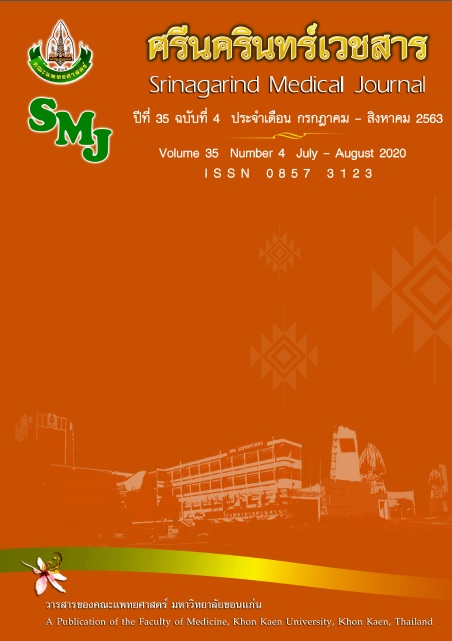Clinical Presentation and Outcomes of Pediatrics Patients Undergoing Evaluation for Drug Allergy in Ramathibodi Hospital
Abstract
ลักษณะทางคลินิก และผลลัพธ์ของผู้ป่วยเด็กที่ได้รับการทดสอบแพ้ยาในโรงพยาบาลรามาธิบดี
ดารา ไม้เรียง1*,วิภารัตน์ มนุญากร2, สุวัฒน์ เบญจพลพิทักษ์2,โสมรัชช์ วิไลยุค2, วสุ กำชัยเสถียร2, จีระพัฒน์ ศศิสกุลพร2, วัลลภา โชติกเสถียร2
1ภาควิชากุมารเวชศาสตร์ คณะแพทยศาสตร์ มหาวิทยาลัยขอนแก่น จ.ขอนแก่น
2ภาควิชากุมารเวชศาสตร์ คณะแพทยศาสตร์ โรงพยาบาลรามาธิบดี มหาวิทยาลัยมหิดล กรุงเทพมหานคร
หลักการและวัตถุประสงค์: การแพ้ยาเป็นปัญหาที่สำคัญ โดยผู้ป่วยจำนวนมากได้รับการวินิจฉัยว่าแพ้ยาโดยไม่ได้รับการทดสอบอย่างเหมาะสมว่าแพ้ยาจริงหรือไม่ การศึกษานี้มีวัตถุประสงค์เพื่อประเมินความชุก ลักษณะทางคลินิก และผลลัพธ์ของผู้ป่วยเด็กที่มีข้อสงสัยแพ้ยาจากประวัติและได้รับการทดสอบแพ้ยา
วิธีการศึกษา: ศึกษาโดยทบทวนเวชระเบียนของผู้ป่วยเด็กที่มีประวัติสงสัยแพ้ยา และมาทดสอบแพ้ยา ณ โรงพยาบาลรามาธิบดี ผู้ป่วยได้รับการยืนยันวินิจฉัยแพ้ยาโดยการทดสอบผิวหนัง และ/หรือทดลองให้ยาที่สงสัยว่าแพ้
ผลการศึกษา: ผู้ป่วยเด็ก 60 รายได้รับการทดสอบแพ้ยา ค่ามัธยฐานของระยะเวลาตั้งแต่ได้รับยาจนถึงมีอาการคือ 4.5 ชั่วโมง พบอาการทางผิวหนังและเยื่อบุได้บ่อยที่สุด (ร้อยละ 95) โดยเฉพาะการบวมใต้ชั้นผิวหนัง และผื่นลมพิษ (ร้อยละ 66.7) ยาที่สงสัยว่าทำให้เกิดอาการแพ้มากที่สุดคือยาต้านปฎิชีวนะ โดยเฉพาะกลุ่มเบต้า-แล็คแตม (ร้อยละ 717.) ยาลดไข้/ต้านอักเสบ (ร้อยละ 7.7) และยาที่ใช้ในระบบหายใจ (ร้อยละ 6.7) มีผู้ป่วยเพียงร้อยละ 26.7 เท่านั้นที่แพ้ยาจริงหลังจากการทดสอบ ปฏิกิริยาต่อการทดลองให้ยาที่สงสัยว่าแพ้ไม่สัมพันธ์กับอาการนำของผู้ป่วย ผู้ป่วยที่แพ้ยาจริงมีลักษณะทางคลินิกต่าง ๆ ไม่แตกต่างกับผู้ป่วยที่ผลการทดสอบเป็นลบ
สรุป: ผู้ป่วยเป็นส่วนน้อยเท่านั้นที่มีภาวะแพ้ยาจริงหลังจากได้รับการทดสอบอย่างเหมาะสม การใช้ลักษณะทางคลินิกไม่สามารถวินิจฉัยแยกผู้ป่วยกลุ่มนี้ได้ ดังนั้นการศึกษานี้จึงช่วยสนับสนุนว่าการทดสอบแพ้ยายังคงเป็นมาตรฐานของการวินิจฉัย
คำสำคัญ: แพ้ยา; การทดสอบแพ้ยา; ลักษณะทางคลินิกของการแพ้ยา
Background and objectives: Drug allergy is a major problem frequently encountered. Patients are frequently over diagnosed as having drug allergy without proper confirmatory tests. The aims of this study were to assess prevalence, clinical presentation and outcomes among pediatric patients suspected of having a drug allergy form medical history, and undergoing drug allergy evaluation..
Methods: Medical records of pediatric patients who had undergone evaluation for drug allergy in Ramathibodi Hospital were reviewed. Patients were confirmed to have a true drug allergy by a positive skin test and/or drug provocation test.
Results: Sixty patients were evaluated for drug allergy. Onset of symptoms was highly variable (median 4.5 hours; min-max 0.08-168). Skin and mucocutaneous reactions were the most common presentations (95%) particularly angioedema and urticaria (66.7%). The most common suspected group of drugs was antibiotics (71.7%), followed anti-pyretic/anti-inflammatory (11.7%) and respiratory drugs (6.7%). Within the group of antibiotics, Beta-lactam antibiotic was the most common suspected drug causing allergy. Only sixteen out of sixty patients (26.7%) were confirmed to have a true drug allergy, 12 patients by skin test and 4 patients by drug provocation test. Drug provocation test reactions did not correlate with presenting symptoms of drug allergy. There were no significant differences in age, onset or primary symptoms of drug allergy between the confirmed true drug allergy and no drug allergy groups.
Conclusions: Drug allergy is frequently reported, but only a minority of patients have true drug allergy. There were no precise clinical predictors for drug allergy. Thus, drug provocation tests remain the gold standard for diagnosis.
Keyword: drug allergy; drug provocation test; clinical presentation of drug allergy
Introduction
Drug allergy is a major problem encountered among general practitioners and allergists1, 2 However, only a few patients have a true drug allergy3. Rashes are major manifestations of drug allergy reactions 4, 5. Children with viral exanthem usually receive medication especially antibiotics for their illness. As a result, when rashes develop, it can be difficult to distinguish rashes from viral exanthem and drug allergy. A number of children with viral exanthem were misdiagnosed with drug allergy in the absent of proper confirmatory testing. This can lead to lifelong avoidance of mislabeled drugs, unnecessary usage of more expensive or less effective second line drugs and increased prevalence of drug resistant bacteria 6, 7. Unfortunately, drug provocation tests used to confirm true drug allergy are insufficiently performed due to concerns about potential reactions especially in children 8.
This study aimed to assess drug allergy prevalence and clinical presentation of drug allergy among pediatric patients suspected of having a drug allergy medical history, , and to determine the safety and outcomes of pediatric patients undergoing evaluation for drug allergy.


